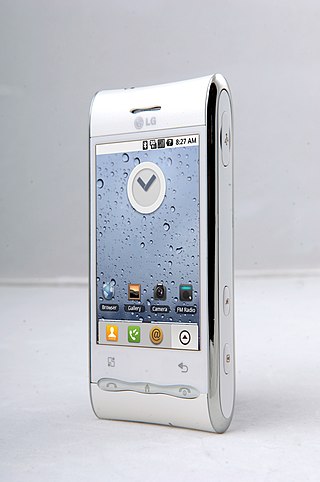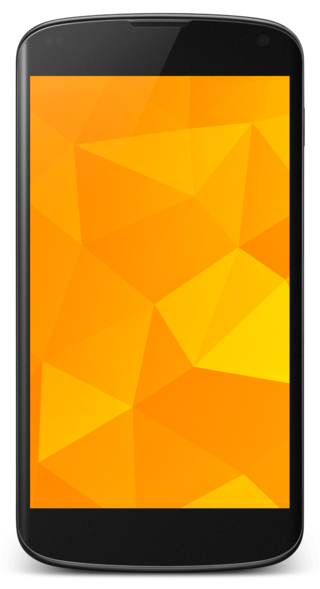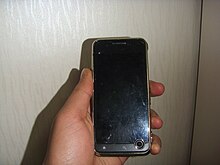
A smartphone is a mobile device that combines the functionality of a traditional mobile phone with advanced computing capabilities. It typically has a touchscreen interface, allowing users to access a wide range of applications and services, such as web browsing, email, and social media, as well as multimedia playback and streaming. Smartphones have built-in cameras, GPS navigation, and support for various communication methods, including voice calls, text messaging, and internet-based messaging apps.

LG Electronics Inc. is a South Korean multinational major appliance and consumer electronics corporation headquartered in Yeouido-dong, Seoul, South Korea. LG Electronics is a part of LG Corporation, the fourth largest chaebol in South Korea, and often considered as the pinnacle of LG Corp with the group's chemical and battery division LG Chem. It comprises four business units: home entertainment, mobility, home appliances & air solutions, and business solutions. LG Electronics acquired Zenith in 1995 and is the largest shareholder of LG Display, the world's largest display company by revenue in 2020. LG Electronics is also the world's second largest television manufacturer behind Samsung Electronics. The company has 128 operations worldwide, employing 83,000 people.

The Open Handset Alliance (OHA) was a consortium of 84 firms to develop open standards for mobile devices. Led by Google, its member firms included HTC, Sony, Dell, Intel, Motorola, Qualcomm, Texas Instruments, Samsung Electronics, LG Electronics, T-Mobile, Nvidia, and Wind River Systems. Android, historically the flagship software of the OHA, is based on an open-source license and has competed against various mobile platforms, most notably iOS from Apple.
A mobile operating system is an operating system used for smartphones, tablets, smartwatches, smartglasses, or other non-laptop personal mobile computing devices. While computers such as typical/mobile laptops are "mobile", the operating systems used on them are usually not considered mobile, as they were originally designed for desktop computers that historically did not have or need specific mobile features. This "fine line" distinguishing mobile and other forms has become blurred in recent years, due to the fact that newer devices have become smaller and more mobile, unlike the hardware of the past. Key notabilities blurring this line are the introduction of tablet computers, light laptops, and the hybridization of the two in 2-in-1 PCs.

A feature phone, brick phone, or dumbphone, is a mobile phone that retains the form factor of earlier generations of mobile telephones, typically with press-button based inputs and a small non-touch display. Feature phones tend to use an embedded operating system with a small and simple graphical user interface, unlike large and complex mobile operating systems on smartphones.
OPhone, or OMS, is a mobile operating system running on the Linux kernel. It is based on technologies initially developed by Android Inc., a firm later purchased by Google, and work done by the Open Handset Alliance. The OPhone OS has appeared only on China Mobile phones, and the software was developed for China Mobile by software firm Borqs. A modified version of OMS has appeared on other carriers as Android+, also developed and maintained by Borqs. Android has been modified for local Chinese markets by China Mobile's OPhone Software Developers Network.

The LG Optimus, also known as the LG Optimus GT540, LG GT540 Swift and the LG Loop GT540, is a mid-level Android smartphone designed and manufactured by LG Electronics. Released running Android 1.6 Donut, the device can be officially upgraded to Android 2.1 Eclair via an LG software release.

The LG Optimus series is a series of smartphones and tablet computers manufactured by LG Electronics. Optimus-branded devices have been produced running both the Android and Windows Phone 7 operating systems.

The LG Optimus One is an entry-level series of touch-screen smartphones manufactured by LG Electronics, Inc. It was released running the Android 2.2 Froyo, and later LG released software to upgrade it to Android 2.3 Gingerbread. Although the basic physical form factor of each variant is the same, the variants have differences in hard button shape and layout, the form of the metal side bezel and the user interfaces added by LG or various carriers. Versions of the Optimus One exist that operate on various frequency bands and either GSM or CDMA-based network protocols. They may also feature one or more variations in hardware, such as a faster processor, the addition of a physical keyboard, a modem with higher theoretical speeds, or a better digital camera.

The LG Optimus 7 is a slate smartphone which runs Microsoft's Windows Phone operating system. The Optimus 7 is part of the first-generation Windows Phone line-up launched in October 2010.

The LG Optimus 2X is a smartphone designed and manufactured by LG Electronics. The Optimus 2X is the world's first smartphone with a dual-core processor and the third phone in the LG Optimus-Android series. LG introduced the Optimus 2X on December 16, 2010 and the device first became available to consumers in South Korea in January 2011. It was also launched in Singapore on March 3, 2011. The Optimus 2X has run the Android 2.3 software version since the upgrade in November 2011, but the latest offering is Android 4.0. The phone holds the record for the longest update holdout, taking 16 months to receive a firmware update from Android 2.2 to 2.3.

The LG Optimus 4X HD is a slate, multi-touch smartphone running the Android operating system. Designed and manufactured by LG Electronics. The Optimus 4X HD was the world's first smartphone announced with a quad-core processor along with the HTC One X and the Samsung Galaxy S3 and the fourth phone in the LG Optimus-Android series. LG first introduced the LG Optimus 4X HD at Mobile World Congress. The Optimus 4X HD was launched with Android 4.0 Ice Cream Sandwich. Since April 2013, some variants have had a Jellybean update available.

The Nexus 4 is an Android smartphone co-developed by Google and LG Electronics. It is the fourth smartphone in the Google Nexus product family, unveiled on October 29, 2012, and released on November 13, 2012, and succeeded the Samsung-manufactured Galaxy Nexus. As with other Nexus devices, the Nexus 4 was sold unlocked through Google Play, but was also retailed by wireless carriers.

LG Optimus L3 is a slate smartphone designed and manufactured by LG Electronics. The Optimus L3 runs on Android 2.3 Gingerbread. The LG Optimus L3 is the budget-range handset in the L series.

The LG Optimus G Pro is a flagship smartphone/phablet designed and manufactured by LG Electronics. It was released in the U.S. on May 10, 2013.

The LG G2 is an Android smartphone developed by LG Electronics. Serving as a successor to 2012's Optimus G and the 2013 Optimus G Pro phablet, the G2 was unveiled at a press event in New York City on 7 August 2013, and first released in September 2013. The G2 is primarily distinguished by software features that LG billed would "learn" from users, a high fidelity sound system designed to produce higher quality audio, a 5.2 in (130 mm) 1080p IPS LCD screen with technology that the company claimed would improve energy efficiency and reduce the size of the bezel around it, along with the unique placement of its power and volume keys—eschewing their typical location on the edge of a smartphone by placing them on the rear below the camera lens.

The LG G series was a line of Android devices produced by LG Electronics. The "G" designation was first introduced in 2012 as a branch of the LG Optimus series for flagship devices, but LG announced in July 2013 that the "Optimus" name would be discontinued for future flagships in favor of maintaining "G" and "Vu" as distinct brands. The first purely G-branded phone, the LG G2, was unveiled in August 2013.

Nexus 5 is an Android smartphone sold by Google and manufactured by LG Electronics. It is the fifth generation of the Nexus series, succeeding the Nexus 4. It was unveiled on October 31, 2013 and served as the launch device for Android 4.4 "KitKat", which introduced a refreshed interface, performance improvements, greater Google Now integration, and other changes. Much of the hardware is similar to the LG G2 which was also made by LG and released earlier that year.
LG Optimus L2 is a slate smartphone designed and manufactured by LG Electronics. The Optimus L2 runs on Android 2.3 Gingerbread. The LG Optimus L2 is the budget-range handset in the L series.

The LG Gx is an Android smartphone developed by LG Electronics. It serves as an update to LG's phablet, the 2012 LG Optimus G Pro, by updating the software and design to that of LG's new flagship, the 2013 LG G2. Other than that, the smartphone is exactly the same as the LG Optimus G Pro with features that include LTE connectivity and an IR blaster, which allows use as a TV remote control. The handset has only been released in Korea on LG's own network, LG U+, as of 20 February 2014 and LG has not commented on whether it will become an international device.
















